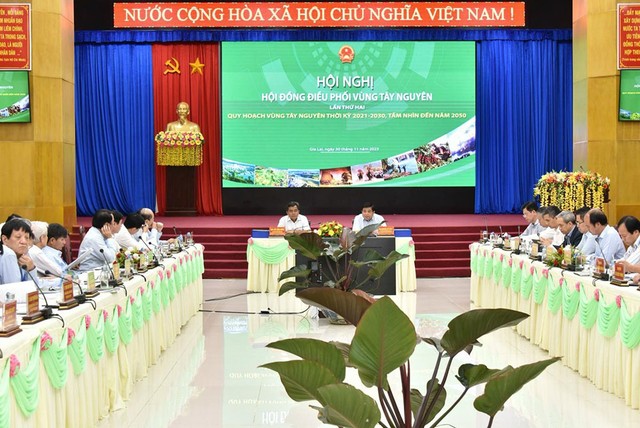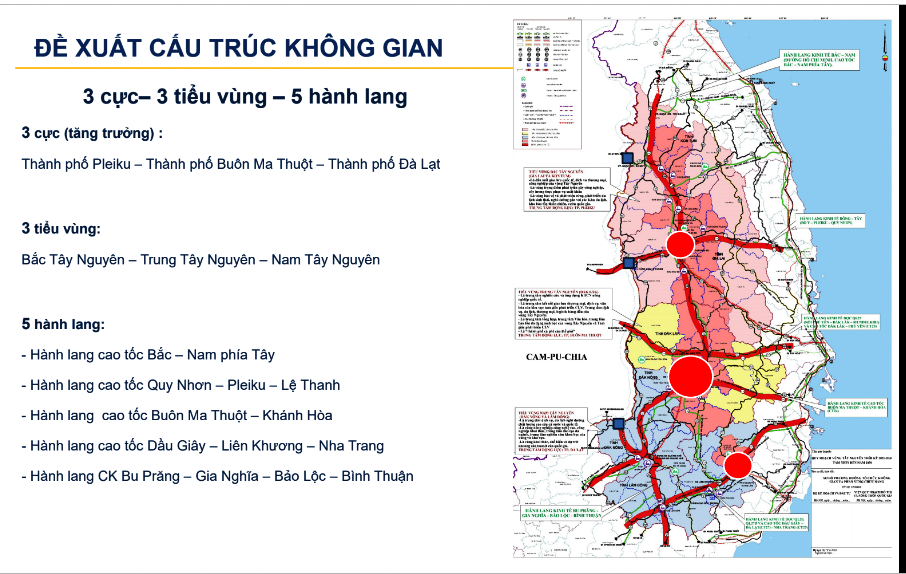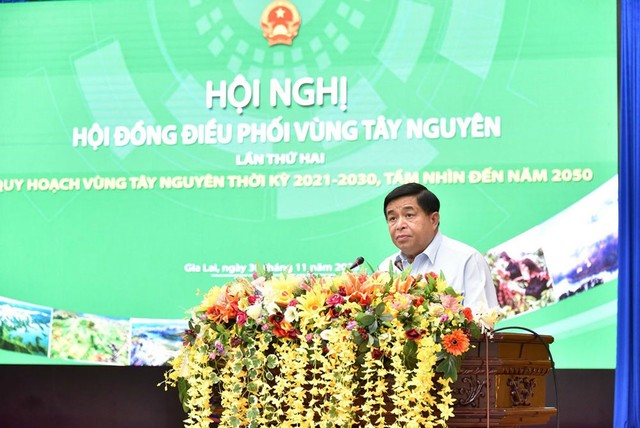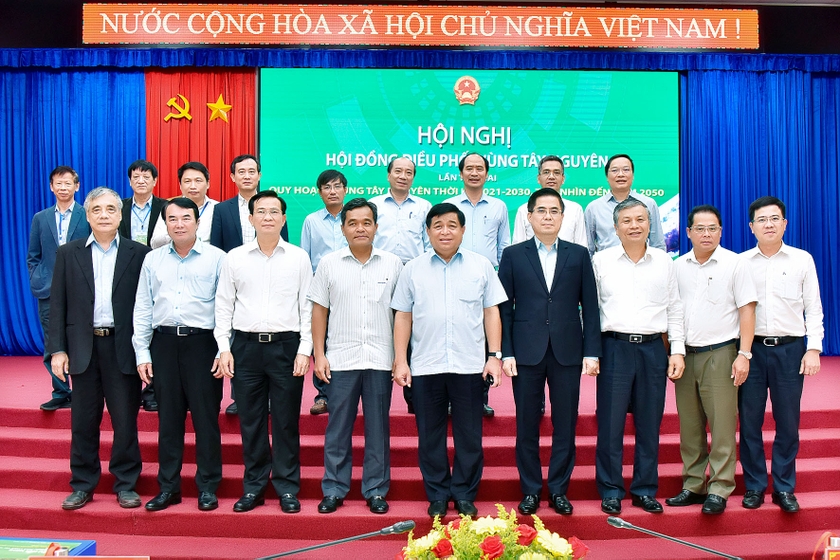The Coordination Council of the Central Highlands recently organized a conference to gather opinions from leaders of central ministries, localities in the region, as well as experts and scientists to contribute ideas and proposals for the draft master plan for the Central Highlands for the period 2021-2030, with a vision towards 2050.

The Coordination Council of the Central Highlands’ second congress (Photo: MPI)
The draft master plan for the Central Highlands has put forward breakthrough proposals to change the development mindset of the region, leverage opportunities, and address obstacles, aiming for "Green – Harmonious – Sustainable" development.
According to the Ministry of Planning and Investment, the role and position of the master plan were clearly defined from the early days of its formulation for the period 2021-2030, with a vision towards 2050. The Ministry collaborated closely with relevant ministries, sectors, and localities in the region to implement the regional master plan. The plan was developed rigorously, thoroughly, and scientifically, based on the specific details outlined in Resolution No. 23-NQ/TW of the Politburo on the direction of socio-economic development and ensuring defense and security in the Central Highlands until 2030, with a vision towards 2045.

The consulting unit for the master plan proposed a scenario for linking the Central Highlands region.
The draft master plan for the Central Highlands presents innovative proposals to change the region's development mindset, capitalize on opportunities, and address obstacles. The plan emphasizes the development of green and circular economy sectors, utilizing the cultural heritage of the Central Highlands as a driver for regional development and integration. Additionally, it advocates for the development of the Central Highlands based on the "3 poles - 3 sub-regions - 5 economic corridors" model. The 3 development poles are Pleiku City, Buon Ma Thuot City, and Da Lat City. The 3 sub-regions include North Central Highlands (Kon Tum and Gia Lai provinces), Central Central Highlands (Dak Lak province), and South Central Highlands (Dak Nong and Lam Dong provinces). The 5 economic corridors consist of 4 high-speed corridors and 1 border gate corridor. The master plan aims to promote the formation of comprehensive and specialized economic centers in the region, leveraging its advantages and position to become growth poles.
During the conference, Chairman of the People's Committee of Dak Lak Province, Pham Ngoc Nghi, expressed high agreement with the content of the draft report on the overall master plan for the Central Highlands for the period 2021-2030, with a vision towards 2050. He noted that the master plan dossier was thoroughly and meticulously prepared, incorporating feedback from relevant agencies and localities.
Dak Lak Province proposed additional directions in the master plan, particularly regarding the allocation of land use targets for localities in case of supplementation or adjustment by the central government. The province emphasized the need for additional guidance on long-term land use needs for localities, as well as the allocation of investment resources from the state budget and non-budgetary sources to contribute to the overall development of the Central Highlands region.
Professor Dr. Tran Dinh Thien, former Director of the Vietnam Institute of Economics, pointed out that the Central Highlands is currently primarily exploiting available natural resources without creating new development impetus and new advantages. The region needs to develop along a value chain rather than developing in isolated sectors. Moreover, the Central Highlands, being a densely populated area, requires prioritization to help it develop.
In addition to the conference, leaders of provinces in the Central Highlands contributed to the draft. Suggestions revolved around accelerating the implementation of high-speed projects, implementing the Prime Minister's Resolution No. 326 on land use planning for national land (2021-2023), and resolving difficulties caused by overlapping plans. There was also agreement on the "3 sub-regions - 3 growth poles - 5 economic corridors" model for the Central Highlands. This includes the need to supplement and clarify details about economic corridors, especially transportation infrastructure connecting the region to overcome bottlenecks and drive the development of the Central Highlands.

Minister of Planning and Investment Nguyen Chi Dung speaking at the conference (Photo: MPI)
Minister of Planning and Investment Nguyen Chi Dung emphasized that with the determination of the government, the Prime Minister, the efforts of ministries, sectors, and localities in the region, as well as the collective contributions of experts and scientists, the Central Highlands Master Plan, with a new mindset and vision, will open up new opportunities and development spaces, contributing significantly to policy research, planning, development programs, investment projects, and helping the Central Highlands region to achieve rapid and sustainable development.
Detailed content and central resources allocation solutions will be proposed in the December 2023 evaluation to the Prime Minister based on the opinions of the Coordination Council.
* Six breakthroughs for the Central Highlands
Additionally, six breakthrough contents for the Central Highlands were identified and proposed during the conference:
First, the master plan asserts the need to innovate the development mindset, proactively seize opportunities, focus resources on solving bottlenecks, conflicts, and obstacles in development, and create mechanisms and policies to generate new growth forces.
Second, emphasis on the requirement for rapid and sustainable economic development based on the exploitation of resources and new sustainable growth drivers. This includes the transition from agricultural production to high-efficiency agriculture, leveraging high-tech applications and digital transformation. Economic development should prioritize key sectors such as agriculture, tourism, processing industry, and renewable energy. The plan aims to gradually restructure and develop the economy towards prioritizing green and circular economic sectors.

Minister of Planning and Investment Nguyen Chi Dung (first row, fifth from right) and leadership of provinces of the Central Highlands. Photo: Duc Thuy
Third, the organization of the region is established based on compliance with natural, ecological, and environmental conservation spaces, ensuring spaces for security and defense regions, and enhancing the advantages and specific development conditions of each sub-region. Developing the Central Highlands region according to the model of "3 poles – 3 sub-regions – 5 economic corridors". In detail: the 3 development poles consist of Pleiku City, Buon Ma Thuot City, and Da Lat City. The 3 sub-regions include the North Central Highlands sub-region (comprising Kon Tum and Gia Lai provinces); the Central Central Highlands sub-region (including Dak Lak province); and the South Central Highlands sub-region (comprising Dak Nong and Lam Dong provinces). There are 5 economic corridors: (i) East-West economic corridor; (ii) Bo Y - Pleiku - Quy Nhon economic corridor; Mundulkiri - Dak Lak - Phu Yen economic corridor; (iii) Buon Ma Thuot - Khanh Hoa high-speed economic corridor; (iv) Dau Giay - Da Lat - Nha Trang high-speed economic corridor; (v) Bu Prang - Gia Nghia - Bao Loc - Binh Thuan economic corridor.
Fourth, the master plan aims to promote the formation of comprehensive and specialized economic centers in the region, focusing on advantages and positions to become growth poles. Urban development and rural population centers should be appropriate to the region's natural conditions and cultural identity. Stable settlements for ethnic minority communities should be prioritized, aligned with their customs and new production methods. Fundamental issues of land use and production land for ethnic minority communities should be ensured and addressed.
Fifth, the master plan aims to promote the formation of comprehensive and specialized economic centers in the region, focusing on advantages and positions to become growth poles. Urban development and rural population centers should be appropriate to the region's natural conditions and cultural identity. Stable settlements for ethnic minority communities should be prioritized, aligned with their customs and new production methods. Fundamental issues of land use and production land for ethnic minority communities should be ensured and addressed.
Sixth, the plan advocates for the maintenance of stability in national parks, nature reserves, species and habitat conservation areas, and historical landscape forest areas with high biodiversity value. It underscores the preservation of rare and precious plant genetic resources in special-use forests. The focus will be on building and strengthening forest conservation areas along the cascade of hydroelectric dams on the Srepok and Ba rivers. The plan supports the development of production forests, including raw material forests, agroforestry, non-timber forest products, urban forestry, and the development of timber processing and trade industries. Steps will be taken to gradually replace groundwater sources with surface water sources. Groundwater sources, as well as facilities using groundwater, will be converted into reserve sources to increase water supply safety.
Kim Bao
- Dak Lak grants the investment approval decision for the Veston Textile - Garment Center Project. (09/04/2025, 15:39)
- The working delegation of the People's Committee of Dak Lak Province visited and extended New Year greetings in Mondulkiri Province, Cambodia. (09/04/2025, 15:36)
- The Conference on the Summary of Forestry Management, Protection, and Development for the Year 2024, Q1 of 2025, and the Implementation of Key Tasks for 2025. (09/04/2025, 15:33)
- Inauguration of the Excellent Teachers Competition for Secondary Schools in Dak Lak Province for the 2024-2025 Academic Year. (09/04/2025, 13:58)
- Prime Minister Pham Minh Chinh: Accelerate and innovate to complete 3,000 kilometers of expressway by the end of 2025. (09/04/2025, 13:54)
- The Women's Entrepreneur Association of Dak Lak Province signed a cooperation agreement for tourism and economic development with the delegation from the Goyang Tourism & Convention Association, Gyeonggi Province, South Korea. (12/03/2025, 09:11)
- Opening Ceremony of the 9th Buon Ma Thuot Coffee Festival 2025. (12/03/2025, 09:04)
- The street festival "Buon Ma Thuot - The Destination for the World Coffee". (12/03/2025, 08:52)
- Opening the Vietnam Specialty Coffee Roasting Competition 2025. (12/03/2025, 08:45)
- The opening of the Coffee Industry Trade Fair and OCOP products exhibition. (10/03/2025, 10:32)
- Worship Ceremony in Commemoration of Revolutionary Soldiers Who Sacrificed at Buon Ma Thuot Prison on the Occasion of the 50th Anniversary of the Victory of Buon Ma Thuot. (10/03/2025, 10:26)

